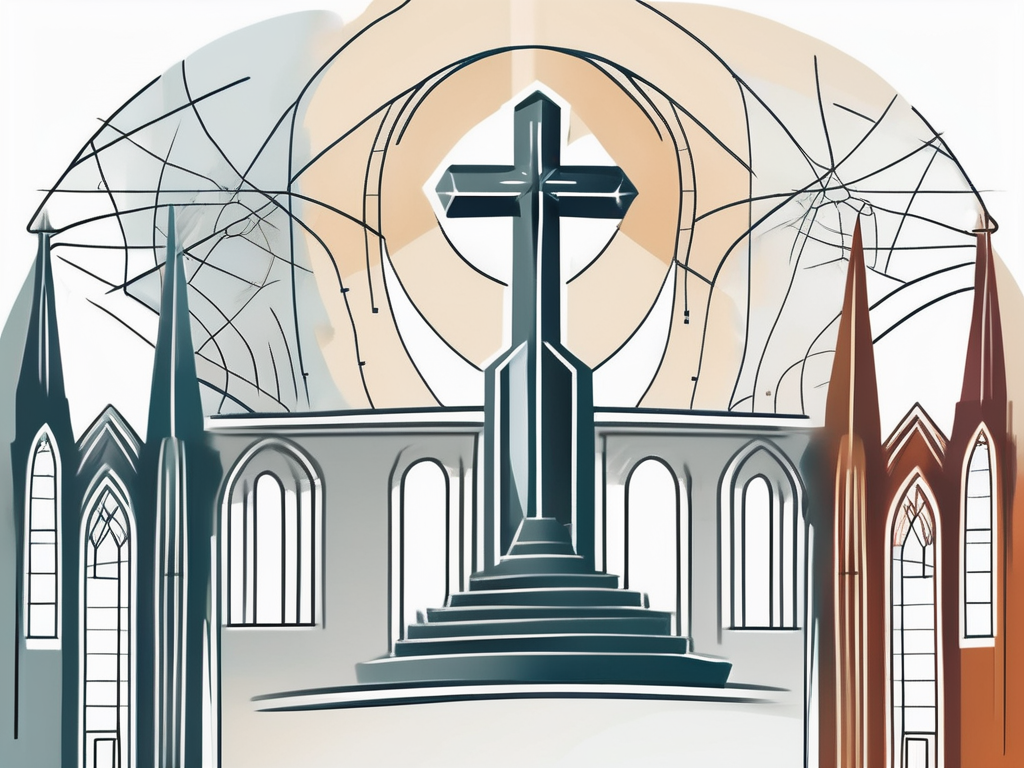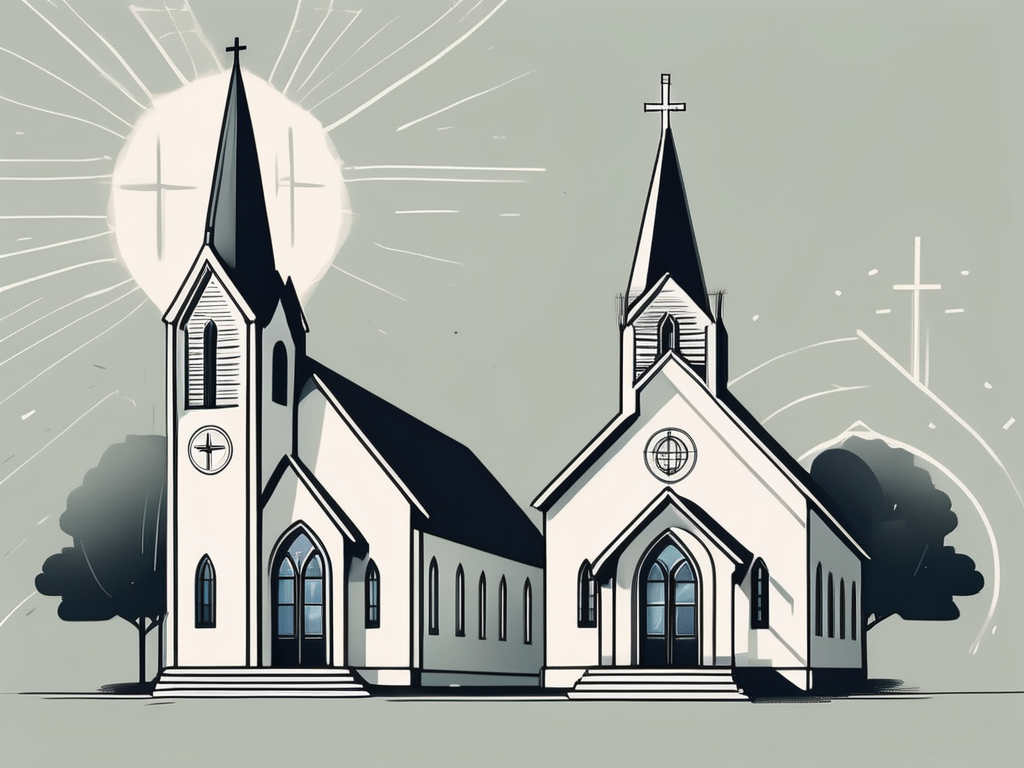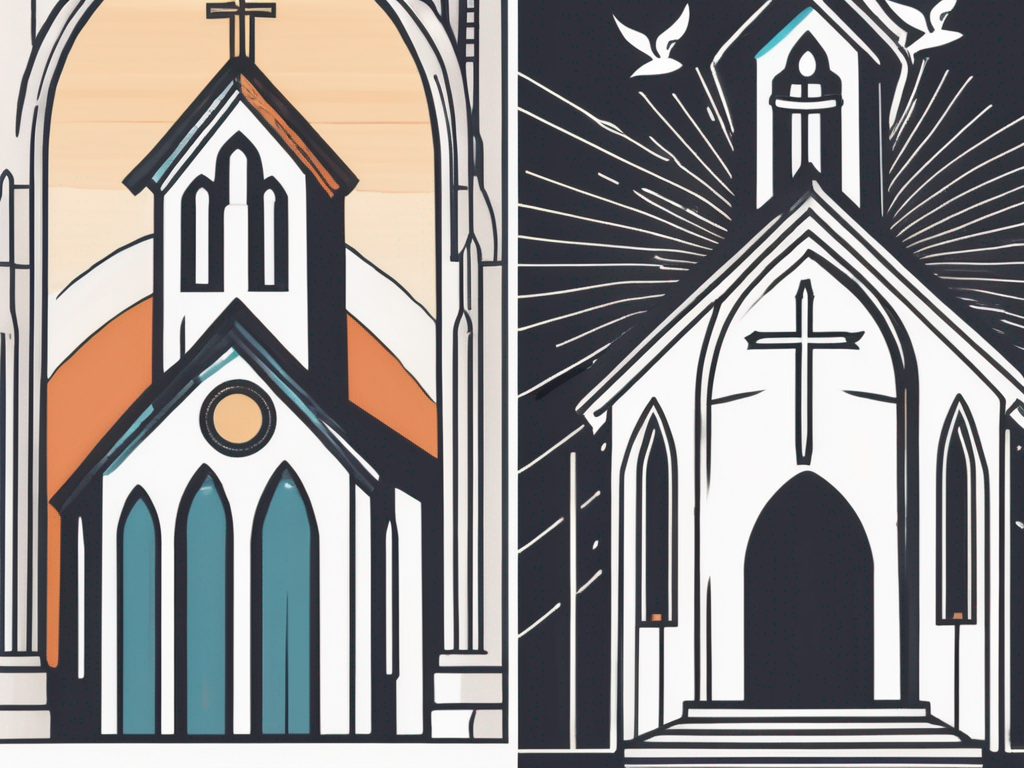In the vast world of Christianity, two branches stand out: Methodism and Protestantism. Although they share some common roots, they have evolved into distinct belief systems with their own unique practices and ideologies. Understanding the differences between Methodism and Protestantism is key to appreciating the diversity within the Christian faith. So, let’s dive deep into these fascinating denominations and explore what sets them apart.
Defining Protestantism: A Brief Overview
Before we venture into the specificities of Methodism, let’s first get a clear understanding of what Protestantism is all about. Protestantism emerged during the 16th-century Reformation period and was a response to certain practices and doctrine upheld by the Roman Catholic Church. Protestantism emphasized the authority of the Bible and rejected the authority of the Pope. It placed emphasis on individual faith, salvation through grace, and the priesthood of all believers.
The Origins of Protestantism
The roots of Protestantism can be traced back to Martin Luther, a German monk who famously nailed his Ninety-Five Theses to the door of the Wittenberg Castle Church in 1517. Luther’s call for reform spread like wildfire, igniting a movement that would forever change the face of Christianity. The Reformation gathered momentum with influential figures such as John Calvin, Ulrich Zwingli, and John Knox contributing to its theological development.
As the Reformation gained traction, various Protestant denominations began to emerge. Each denomination had its own unique beliefs and practices, but they all shared a common desire to reform the church and return to the teachings of the Bible. These denominations included Lutheranism, Calvinism, Anglicanism, Anabaptism, and many others. The diversity within Protestantism allowed for a wide range of theological perspectives and worship styles.
One of the key aspects of Protestantism was its emphasis on the priesthood of all believers. Unlike the Catholic Church, which reserved the role of priests for a select few, Protestants believed that all believers had direct access to God and could serve as ministers of the Gospel. This idea empowered individuals and encouraged them to take an active role in their faith communities.
Key Beliefs and Practices of Protestants
Protestants uphold several core beliefs that distinguish them from other denominations. They believe in the sole authority of the Bible, known as Sola Scriptura, viewing it as the ultimate guide for faith and practice. This belief stems from the conviction that the Bible is the inspired word of God and contains all the necessary teachings for salvation and Christian living.
In addition to Sola Scriptura, Protestants advocate for salvation by faith alone, emphasizing the need for a personal relationship with Jesus Christ as the basis for salvation. They believe that salvation is a gift from God, received through faith, and cannot be earned through good works or religious rituals. This emphasis on faith and grace highlights the Protestant belief in the unmerited favor of God.
While there is diversity among Protestant traditions, most uphold the sacraments of baptism and communion as important acts of obedience. Baptism is seen as a symbolic representation of a believer’s identification with Christ’s death, burial, and resurrection. Communion, also known as the Lord’s Supper or the Eucharist, is viewed as a commemoration of Jesus’ sacrifice and a means of spiritual nourishment.
It is important to note that the significance and practices of these sacraments may vary among different Protestant denominations. Some denominations practice infant baptism, while others only baptize believers who have made a personal profession of faith. Similarly, the understanding of communion ranges from a symbolic act to a belief in the real presence of Christ in the elements.
Overall, Protestantism is a diverse and dynamic movement within Christianity. It encompasses a wide range of beliefs, practices, and traditions, all united by a common desire to follow the teachings of the Bible and live out their faith in a personal and meaningful way.
Unraveling Methodism: An Introduction
Now, let’s shift our focus to Methodism, a branch that originated within the Protestant movement. Methodism emerged in 18th-century England as a revival movement led by John Wesley and his brother Charles Wesley. It quickly gained popularity for its emphasis on personal piety, communal worship, and social justice. Today, Methodist churches can be found all around the world.
The Birth of Methodism
Methodism owes its name to the systematic approach to spiritual disciplines and lifestyle advocated by its early leaders. John Wesley encouraged his followers to adopt a methodical approach to spiritual growth through prayer, Bible study, fasting, and acts of charity. The Methodist movement, known for its energetic and emotional style of worship, drew large crowds and made Christianity accessible to a wider spectrum of society.
As the Methodist movement spread, it faced opposition from some established churches. However, the passion and dedication of its followers could not be contained. They formed societies and classes where they could gather for worship, study, and mutual support. These small groups became the backbone of the Methodist movement, providing a sense of community and accountability.
One of the key aspects of Methodism was its commitment to social justice. John Wesley believed that faith in Christ should lead to a transformation of the individual and society. He actively spoke out against social injustices such as slavery and advocated for the rights of the poor and marginalized. This emphasis on social justice became a defining characteristic of Methodism.
Fundamental Tenets and Rituals of Methodism
Methodism upholds many of the core beliefs found in Protestantism but also places specific emphasis on social justice and holiness. Methodists believe in faith in Christ leading to transformation, known as sanctification, over a lifetime. They are encouraged to actively engage in works of mercy, seeking justice and tending to the needs of the marginalized.
In addition to their commitment to social justice, Methodists also practice two sacraments: baptism and communion. Baptism is seen as a symbol of initiation into the Christian faith and a sign of God’s grace. Communion, also known as the Eucharist or the Lord’s Supper, is a sacred ritual where Methodists believe they partake in the body and blood of Christ. These sacraments are seen as outward signs of God’s grace at work in their lives.
Methodist worship services are characterized by their vibrant and participatory nature. Congregants are encouraged to actively engage in singing hymns, praying, and listening to sermons. The music plays a significant role in Methodist worship, with hymns often expressing the theology and values of the Methodist tradition.
Methodism has had a profound impact on society throughout history. Its emphasis on personal piety, social justice, and community has inspired countless individuals to work for positive change in the world. Methodist churches continue to be places of worship, fellowship, and service, providing a spiritual home for millions of people worldwide.
Protestantism vs Methodism: A Comparative Analysis
Now that we have established a foundation for both Protestantism and Methodism, let’s delve into deeper distinctions between the two. While Methodism falls under the umbrella of Protestantism, it possesses its own theological and liturgical characteristics that set it apart.
Protestantism, as a broad term, encompasses various Christian denominations that originated from the Reformation movement in the 16th century. Methodism, on the other hand, emerged as a distinct movement within Protestantism in the 18th century, led by John Wesley and his brother Charles Wesley.
Theological Differences
One key theological difference between mainstream Protestantism and Methodism lies in the understanding of salvation. While both emphasize salvation by faith, Methodism takes it a step further by emphasizing the process of sanctification, the ongoing transformation of believers into Christlikeness. This focus on holiness shapes Methodists’ understanding of sin, redemption, and the Christian journey.
Methodism places a strong emphasis on personal piety and the pursuit of holiness in everyday life. This emphasis is rooted in John Wesley’s belief in the possibility of Christian perfection, where believers can attain a state of entire sanctification and live a life free from willful sin. This concept of perfectionism sets Methodism apart from many other Protestant denominations.
Differences in Worship Style and Rituals
Another notable difference between Protestantism and Methodism lies in their worship styles. While many Protestant churches often embrace a more informal and contemporary approach to worship, Methodist services retain a more traditional and structured format. Methodists follow a liturgy that includes hymns, prayers, responsive readings, and a sermon. This intentional structure helps foster a sense of reverence and order within the worshiping community.
Methodist hymnody holds a special place within the tradition, with hymns like “And Can It Be” and “O for a Thousand Tongues to Sing” being widely sung and cherished. These hymns not only express theological truths but also serve as a means of spiritual formation and communal worship.
Organizational Structure: How They Differ
In terms of organizational structure, Protestantism encompasses a wide range of denominations with varying levels of hierarchical organization. Some Protestant denominations, such as Presbyterianism, have a more centralized structure with governing bodies like synods and presbyteries. Others, like Baptist churches, tend to have a more congregationalist approach with each local church being autonomous.
On the other hand, Methodism follows a connectional system whereby churches are grouped into conferences overseen by bishops. This system allows for collaboration and accountability among Methodist churches while providing a sense of unity in mission and purpose. The highest governing body in Methodism is the General Conference, which meets every four years to make decisions on matters of doctrine, polity, and social issues.
Methodist bishops, unlike bishops in some other Christian traditions, are not seen as having a higher sacramental authority but rather serve as spiritual leaders and administrators within the connectional system. They are responsible for appointing and overseeing pastors, ensuring the spiritual well-being of the churches under their care, and promoting the mission of the Methodist Church.
Furthermore, Methodism places a strong emphasis on lay leadership and involvement. Laypeople are encouraged to actively participate in the life and ministry of the church, serving in various roles such as lay preachers, class leaders, and members of administrative committees.
In conclusion, while Methodism falls under the broader category of Protestantism, it has distinct theological, liturgical, and organizational characteristics that set it apart. The emphasis on sanctification, the structured worship style, and the connectional system of church governance contribute to the unique identity of Methodism within the Protestant tradition.
Common Misconceptions About Methodists and Protestants
Throughout history, misunderstandings and misconceptions have inevitably arisen around different denominations. Let’s debunk some common misconceptions associated with Methodism and Protestantism.
Misunderstood Beliefs
Contrary to popular belief, Methodism is not a separate religion but rather a distinct branch within Protestantism. Methodists fully embrace the foundational beliefs of the Protestant faith, with their distinct emphasis on holiness and social action. Similarly, Protestants are not a homogeneous group but encompass a wide variety of denominations with differing beliefs and practices.
Clarifying the Confusion
It is crucial to approach discussions regarding denominational differences with an open mind and a willingness to learn from one another. Engaging in interfaith dialogue can dispel misconceptions and foster a deeper understanding of our shared Christian heritage. Remember, unity in faith does not require uniformity in practice.
The Impact of These Differences on Individual Believers
Understanding the differences between Methodism and Protestantism goes beyond mere academic curiosity. These differences have profound implications for individual believers as they navigate their spiritual journeys.
Choosing a Path: Personal Implications
For individuals seeking a church community, understanding the distinctive beliefs and practices of Methodism and Protestantism can help guide their decision-making process. Factors such as theological alignment, worship style, and opportunities for community engagement are significant considerations that can impact one’s spiritual growth and sense of belonging.
Community and Cultural Differences
The diversity within the Christian tradition is beautiful and enriching. By recognizing and appreciating the nuances between Methodism and Protestantism, we foster a spirit of unity while embracing the beauty of our differences. Community and cultural variances can shape the worship experience, church traditions, and social outreach efforts, presenting believers with opportunities to engage with a wide range of expressions of faith.
In Conclusion
Methodism and Protestantism, though sharing common roots, have distinct characteristics that set them apart within the expansive Christian tradition. From the origins of Protestantism to the birth of Methodism, and from theological differences to worship styles, it is crucial to acknowledge and appreciate the diversity within the Christian family. Understanding these differences empowers believers to make informed choices and engage in meaningful dialogue, promoting mutual respect and fostering a deeper understanding of faith.












